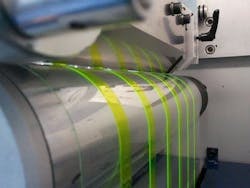Organic light-emitting electrochemical cells produced on printing press
Umeå, Sweden--Ludvig Edman and Andreas Sandström at Umeå University report that they have produced organic light-emitting electrochemical cells (LECs) using a roll-to-roll-compatible process under ambient conditions. The experiments were carried out in collaboration with Frederik Krebs and Henrik Dam at the Technical University of Denmark, where they have extensive experience of low-cost roll-to-roll fabrication of organic solar cells.
“LECs can thus be produced as inexpensive and large-area extremely thin light-emitting devices for informative displays and, at a later stage, lighting applications,” says Ludvig Edman, a physics professor. The work was reported in the August issue of Nature Communications.
Edman’s group at Umeå University is focusing on novel organic compounds (such as light-emitting and conducting polymers and graphene) and develops LECs based on such materials. The researchers have dramatically improved the energy efficiency and lifetime of LECs and have recently enhanced the performance of LECs to a point where lifetime and efficiency make LECs useful for signage applications.
The next step in the development was to ensure that the manufacturing costs can be attractive for commercial applications. The report shows that using solely air-stable materials in a roll-coater apparatus, the team managed to deposit a light-emitting layer and a PEDOT-PSS (a polymer mixture) anode on top of a flexible cathode-coated substrate mounted on a roll by means of a slot-die head.
The layers in the produced LEC device were found to be highly uneven, and the layer thickness, for both active layer and anode, was very thick at approximately 1 µm. However, due to the unique self-doping operation of the LEC, the light emitted did not suffer from the rough interfaces, and was in fact found to be very uniform. This feature is ideal for roll-to-roll processes, as the demands of the coating quality can be relaxed thus lowering the costs substantially.
It is notable that all the steps involved, such as preparation of inks, the subsequent coating of the constituent layers, and the final device operation, all could be executed under ambient air.
Ludvig Edman is the founder and Andreas Sandström the chief technical officer of the Umea-based company LunaLEC, where LECs are being developed for commercial applications.
See http://www.physics.umu.se/english/research/photonics/organic-electronics/
About the Author
John Wallace
Senior Technical Editor (1998-2022)
John Wallace was with Laser Focus World for nearly 25 years, retiring in late June 2022. He obtained a bachelor's degree in mechanical engineering and physics at Rutgers University and a master's in optical engineering at the University of Rochester. Before becoming an editor, John worked as an engineer at RCA, Exxon, Eastman Kodak, and GCA Corporation.

